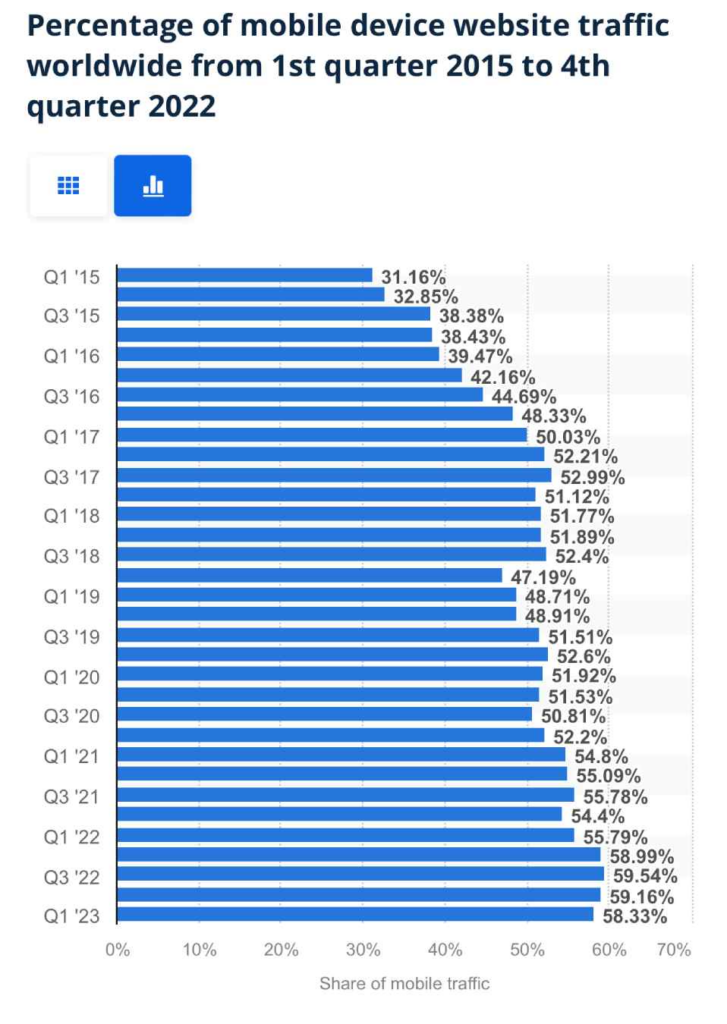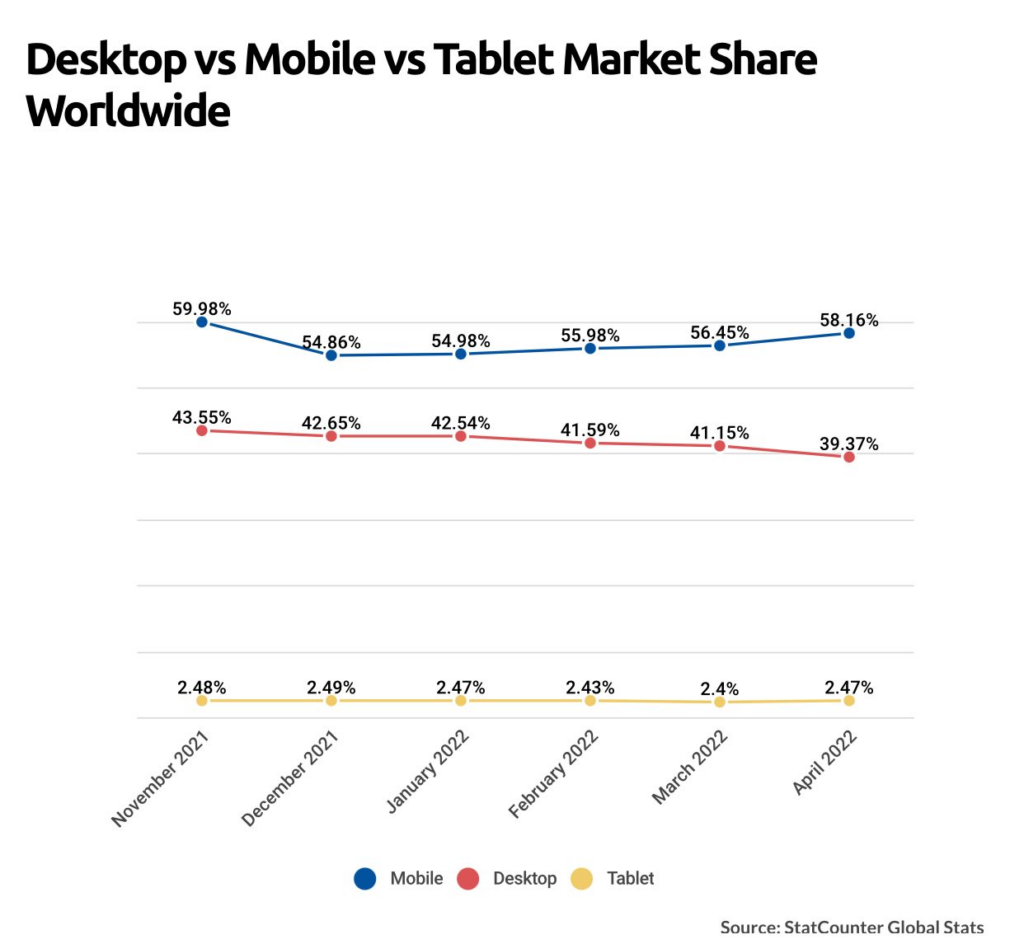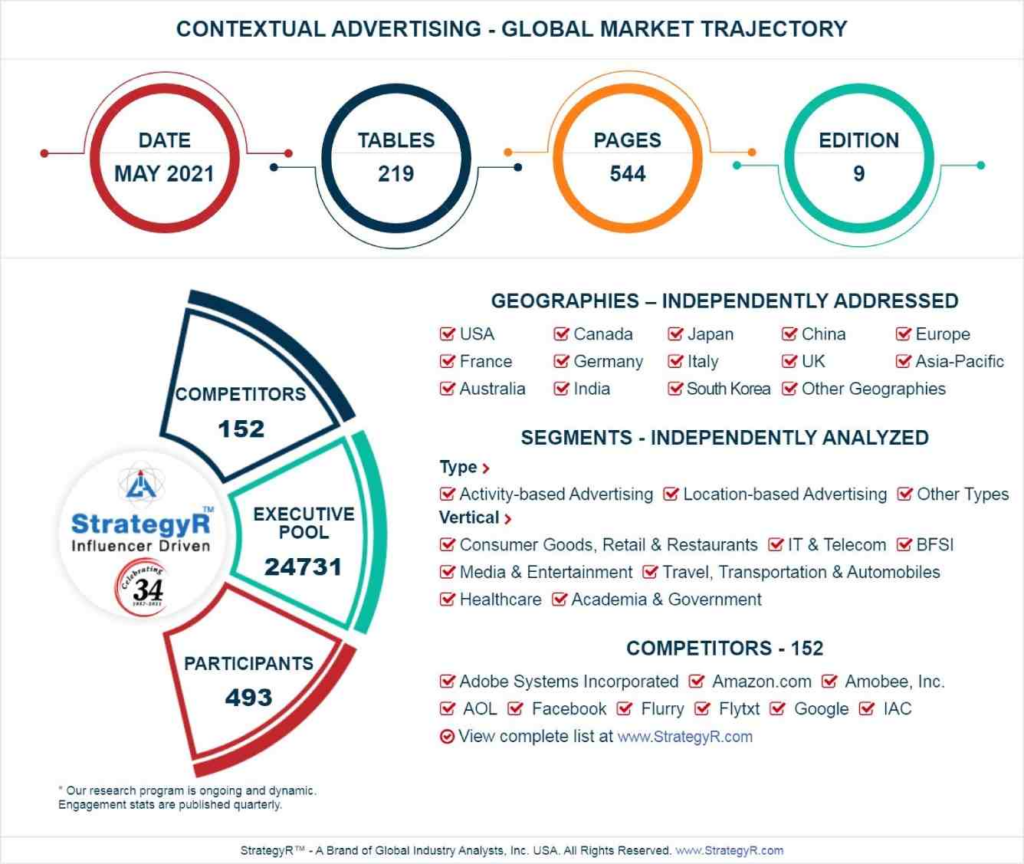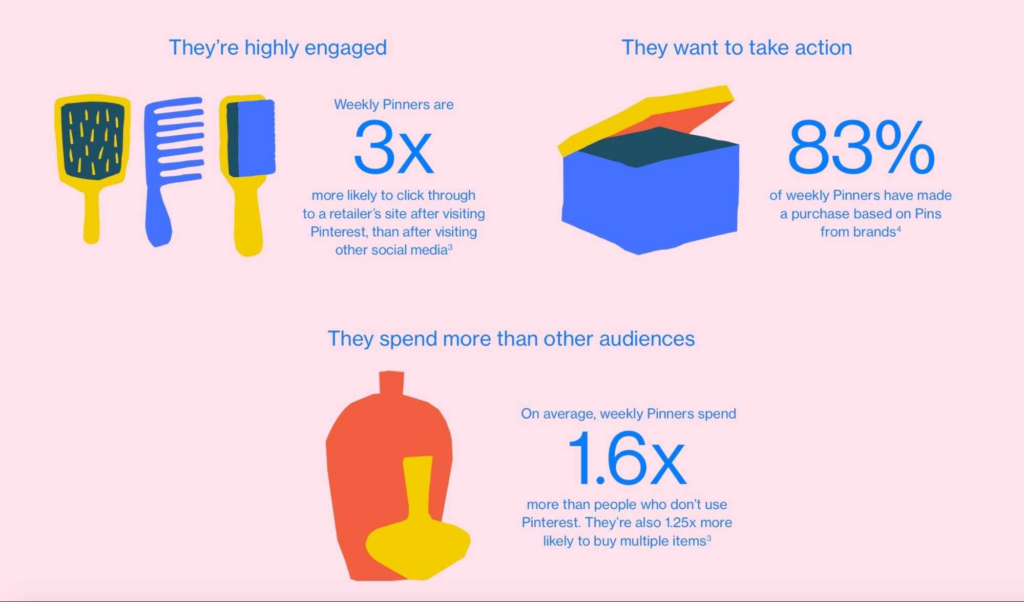Software used to be created with desktop computing in mind, and mobile access was considered secondary. However, designers and developers are rapidly adopting a mobile-first strategy because about 60% of all online traffic worldwide now comes from smartphones or other mobile devices. This article of Devlight.io gives a general overview of mobile-first development, describing how it works in terms of advertising and outlining the main components of mobile-first marketing.
- Significance of a Mobile-First Approach in Advertising and Promotion
- Optimizing Promotion for Mobile Devices
- Contextual Advertising for Mobile Devices
- Effective Targeting and Segmentation
- Mobile Apps and Social Media Integration
- Best Practices for Mobile-First Optimization
- Future Trends and Considerations
- Bottom Line
Significance of a Mobile-First Approach in Advertising and Promotion
Targeted marketing, as opposed to conventional advertising, enables advertisers to present their content to a particular target audience. The popularity of mobile programmatic advertising, as it is also called, serves as a reminder of the value of mobile user data in user segmentation. Going mobile-first enables advertisers to interact with and meaningfully engage their audience.
Understanding the Mobile-First Approach
A design strategy known as “mobile first” puts users of mobile devices at the center of online and app development. Ukrainian dedicated developers, designers, and marketers are emphasizing mobile devices as their “primary platform” for digital products as the percentage of users who use them rises. This indicates that the small touchscreen is taken into consideration throughout the entire app development and promotion process, with modified versions for desktops, laptops, and other “large screen” devices following.
When Google CEO Eric Schmidt explained his offer that designers should embrace a mobile-first norm in their work in 2010 at the Mobile World Congress in Barcelona, it was a big surprise to the world. This is when the phrase “mobile first” was first used.
Now this phenomenon seems quite reasonable given the rise in mobile users as well as the fact that building something “small” and later expanding it for a larger configuration makes more sense and may even be simpler than doing it the other way around. However, back then, voicing this approach was a huge milestone in revolutionizing app development as such.
Definition and Principles of the Mobile-First Approach
In contrast to the conventional method of developing a desktop site first and then adapting it to smaller displays, a “mobile-first” strategy entails designing a desktop site starting with the mobile version. In general, a mobile-first strategy entails developing your website with your mobile visitors in mind, with the primary objective of enhancing their experience on your site or in-app.
With a mobile-first approach to digital marketing, advertisers build their products giving preference to mobile device versions over desktop ones. Due to the popularity of mobile internet browsing and online purchasing among customers, many businesses today are primarily using this method in their marketing efforts.
Initially a somewhat uncommon technique in the marketing sector, mobile-first strategies are becoming more prevalent because also due to the growth of digital media platforms. With the choice of major search engines and tech businesses to favor mobile versions of their websites, mobile-first marketing techniques may have already become a new standard.
Key Benefits of Adopting a Mobile-First Strategy
Any company planning to use third-party data to complement its own first-party data and improve data analysis can turn to data providers. This allows for better feature engineering and data at scale.
Statista data revealed that by the end of this year, global spending on mobile-first advertising is anticipated to hit a record high of US$327.1 billion. By 2024, spending is anticipated to reach about US$399.6 billion, a 17.2 percent rise from the most recent estimate.
Adopting a mobile-first strategy for digital advertising campaigns, bring a number of advantages.
- Greater customer retention and reach: the mobile-first strategy offers the chance to attract new clients. Your company may access new markets while enabling streamlined product delivery. So, if expanding into new markets and developing new revenue streams are goals for your brand, going mobile-friendly should be your choice.
- Enriched customer experience: when advertisers adopt a mobile-first strategy for their campaigns, it may outperform all other digital solutions in terms of user experience and site performance. Mobile-enabled apps offer a customized user experience with a focus on the preferences of your target audience as customers become more mobile.
- Strong brand-customer relationships: a mobile-oriented approach has several advantages when it comes to communication and engagement between marketers and their target audience. With many people actively looking for additional ways to interact with your brand, advertisers who have excellent customer relationships increase their brand’s credibility, adaptability, and functionality.
- New revenue channels: consumers can access a variety of monetization options through mobile-enhanced apps, including in-app purchases, purchasing promoted goods, constant upgrades, and premium features.
Optimizing Promotion for Mobile Devices
To ensure effective website design, structure, and content, advertisers can apply a mobile-oriented approach in a variety of ways. These techniques consist of different elements.
Responsive Design and Mobile-Friendly Content
Your potential to rank higher in searches could be harmed if your mobile site is missing entire pages and content that is available on desktop sites. Build your page initially for mobile devices, then scale it up for desktop browsers to avoid making this error. Besides, be sure to maintain visual consistency between desktop and mobile web pages. For mobile-enabled apps, this entails deleting unsupported image formats and maintaining the same descriptions, captions, and alt text for photos.
Designing a responsive website is important since it affects how well your site will rank. Use site builders that enable you to easily develop content for several platforms to maximize the effectiveness of your mobile-first strategy.
Strategies for Creating Mobile-Friendly Content
The first three seconds of user engagement are the most important. Advertisers must create short, clear, and simple messages for customers to understand. Make an effort to ensure that customers can understand the message within a few seconds because the majority of people will scroll past an ad in a few seconds.
A great data vendor to collect mobile data from your targeted audience group will help you implement a strong mobile-first strategy. The mobile data processing model should be entirely algorithm-based, predictive, and privacy-compliant. This way you will learn more about your target audience and offer them content tailored specifically to their needs.
Mobile-Specific Promotional Techniques
The app market is in need of smart marketers. According to Business of Applications, TikTok, Instagram, Facebook, WhatsApp, and Telegram are among the top five applications worldwide. However, there are hundreds of thousands of additional apps, which is why in-app advertising has developed into a crucial component of mobile marketing strategies.
Because you can adapt common local marketing strategies that you may already be familiar with to be mobile-friendly, mobile marketing is quite simple to incorporate into your present marketing strategy. Here are a way examples of how to do this.
Leveraging Push Notifications and In-App Messages
Push notifications are clickable pop-up messages an application delivers to a user’s mobile device. If a user has loaded your mobile app on their phone and has chosen to accept push notifications, you can then share promotions, remind the user to visit the app, and inform them of news instantly.
Notifications are practical marketing tools that can entice users’ interest, raising the engagement rate of an app. They may also contribute to expanding and improving your brand’s market recognition, both of which may have a favorable effect on the lead generation process.
Mobile push messages are quite economical, which is an important consideration, especially for startup businesses without financial support or those who are new to the mobile app market. They are also a strong competitor to SMS marketing and a quicker, simpler alternative to text communications.
Utilizing Mobile Ad Formats, e.g., Native Ads, Interstitial Ads
In-app advertising comes in several forms:
- mobile screens’ top- and bottom-positioned display advertisements, such as banners;
- native advertising, or ads designed to look like they belong in an app;
- ad videos;
- ads that intersperse app operations are known as interstitials.
Native advertisements don’t appear like advertisements. Instead, they appear to be natural pieces of content that smoothly integrate into the user’s experience. The ad format closely resembles that of the original app format, making it difficult to tell it apart from the surrounding information. Being a powerful form of advertising, native ads encourage users to explore brand material without interfering with their experience.
Interstitial advertisements are especially interactive since they appear across the entire screen, frequently as an app is loaded or right after it has been closed. Interstitials, which frequently include appealing and inventive call-to-actions, give users the ability to connect highly with the subject matter of an advertisement.
Location-Based Targeting and Personalization
According to research, the global location-based advertising industry, which already had a value of more than $62 billion USD in 2019, is predicted to expand at a rate of more than 17% between 2022 and 2027 because it is more pertinent to where and what mobile consumers are doing. This sort of marketing generates greater engagement and better responses.
Harnessing Geolocation Data for Targeted Promotions
If your small business offers a mobile app or site, you can target local mobile users using location-based marketing strategies like geofencing. This is especially helpful for small companies with physical stores. Additionally, it may be useful for e-commerce websites that provide recommendations for nearby services like meal delivery or tourism.
The GPS feature on smartphones is used by location-based marketing to assist advertisers in displaying promotions and pertinent material based on users’ geolocation. Geotargeting and geolocation marketing are other names for location-based marketing.
Customizing Content Based on User Preferences and Behavior
Personalizing and customizing user content is achievable through audience targeting. You can target your customers depending on things like:
- demographics;
- behavior online and off;
- current and previous behavior;
- interest location.
As a result, you may use mobile marketing to contact clients when they’re most likely to make a purchase. For instance, if a consumer has been in your physical store, you can email them an offer based on what they did there and share a discount code for online purchases.
Additionally, you can incorporate audience targeting, geo-fencing, and location marketing into your mobile marketing to make it even more relevant to your potential clients.
Contextual Advertising for Mobile Devices
Mobile marketing is seeing a rebirth of contextual advertising. Contextual advertisements are returned to being widely used as many iOS users choose not to participate in data tracking, and mobile marketers search for fresh approaches to target the correct customers.
In recent years, behavioral targeting has dominated mobile marketing tactics. However, in-app behavioral data has grown more elusive due to new privacy laws and regulations, such as the App Tracking Transparency (ATT) framework.
Therefore, smart marketers are now returning to the tried-and-true strategy of contextual advertising. According to a recent study, the global market for contextual advertising is expected to grow to $335.1 billion by 2026. It’s crucial that mobile marketers and user acquisition managers add this tactic to their marketing toolset in light of the recent changes in user privacy.
Understanding Contextual Advertising
Ads are delivered to users based on their browser history and user behavior. Marketers may now deliver increasingly individualized adverts thanks to this technique. For instance, a consumer who was checking on the trendy pair of Nike shoes online then notices a Nike shoe advertisement on social media, a news app, and a gaming app. With behavioral targeting, the advertisement is tailored to the user rather than the context in which it is viewed.
A contextual advertisement, in contrast, is based on the surroundings or “context” in which it appears. A Nike shoe advertisement might only reach the user on a shopping site or in a fitness app.
Definition and Relevance in the Mobile Context
An automated advertising approach called contextual advertising uses algorithms to connect an advertisement with pertinent material on a website or mobile app. A food delivery service might decide to run advertisements on the Pinterest app to reach individuals looking for recipes. Alternatively, a cryptocurrency exchange platform would choose to target users by posting an ad in a finance app. Cross-selling can also be accomplished through contextual advertising, like in the case of a gaming commercial appearing in another game of a similar genre.
Benefits of Contextual Advertising for Mobile Devices
In the current mobile ecosystem, contextual advertising became truly essential since it gives advertisers a simple approach to locating audiences who could be interested in their goods or services without the need for behavioral data. Contextual advertising generally protects user privacy, is relevant, and can help reduce ad fatigue by raising the quality of the content ads are embedded in.
Context can even increase the effectiveness of your advertisement. “Alignment between ad and context (the channel) can amplify halo effects, meaning an ad is more likely to be processed as well as viewed favorably,” says Chris Huebner of Volt. Performance-related messaging or businesses in the health and wellness sector have a stronger possibility, given that Spotify is probably used in a gym environment.
Effective Targeting and Segmentation
The processes of identifying a company’s potential consumers, selecting the customers to pursue, and producing value for the targeted customers are referred to as market segmentation and targeting. Segmentation, targeting, and positioning (STP) are used to accomplish it.
Leveraging User Data and Demographics
Consumers are most frequently segmented by taking into account geography, demographics, psychographics, behavior, and advantages sought. The consumer’s lifestyle, passions, viewpoints, and personality are all considered psychographics. Benefits sought are the values the consumer is seeking, such as convenience, price, and status associated with the product. Behavior is the loyalty, purchase occasion, and usage rate of the buyer.
By asking why, what, and who, you can segment consumers in another way highly personalized.
- Understanding consumer behavior is a more challenging but crucial task for businesses when segmenting their customer base. The “why” question focuses on this. Companies can accurately forecast future purchases by gathering data on a consumer’s prior purchases. This enables businesses to target the appropriate consumer.
- The “what” focuses on purchasing patterns. Companies can segment the data they are interested in based on its recency, frequency, and monetary value. These three items reflect how recently a consumer visited the store, how regularly they shop there, and how much money they spend there. They aid businesses in evaluating the worth and loyalty of their customers.
- Because the data is so easily accessible, segmenting consumers by “who” is perhaps the simplest method. Information on a person may include things like age, family size, income, and education. Companies anticipate that these attributes will closely match consumer needs. For instance, if a person is in their mid-40s and has a large family, the automaker will probably promote an SUV rather than a two-seater to them.
Implementing Dynamic Ad Placement Based on Context
Dynamic advertisements’ content, promotions, and calls-to-action, also known as dynamic banner ads or dynamic creatives, alter according to user behavior. They assist marketers in distributing more pertinent advertisements that resonate with their target markets.
To reach consumers who have already interacted with a brand, marketers use dynamic advertising. Instead of adapting to outside data, static advertisements tend to target bigger demographic groups for brand awareness or product launches.
Mobile Apps and Social Media Integration
People are influenced by social media to purchase goods from their preferred brands. In fact, 83% of American customers admitted buying something under the influence of their favorite brand sharing a post highlighting the item. The main objective of the majority of businesses is brand awareness when it comes to social media strategy.
The amount spent on social media advertising in the US is expected to reach $67.4 billion this year. ATT has severely hurt social networking apps since many of the behavioral data points they were used to target ads are no longer available. Contexts can still be useful for social media applications, though.
On apps like Facebook, Pinterest, or Instagram, users frequently divulge a lot of information about their interests. They like posts, join groups, and exchange basic profile information — all of which can be used for relevant advertising. A user who is actively searching for a certain hashtag or term lets you know exactly what interests them. It would be clever to deliver your adverts using this contextual information to help grab attention.
Incorporating Contextual Ads in Mobile Apps
Contextual advertising demands meticulous attention to detail and a dedication to optimization, just like any other marketing technique. Thus, here are some advices for you.
- Diversify: don’t concentrate solely on one kind of advertisement, such as a search, social, or display one. Don’t become fixated on a single set of keywords, as well. Instead, use a variety of ad formats and keywords to increase your audience conversion.
- Knowing your audience is key to making sure that your advertisements are seen by the proper people. You can identify the best ad placements and employ the perfect messaging by analyzing the websites targeted users visit frequently and the subjects they are interested in.
- Don’t disregard less popular keywords: SEO has trained marketers to concentrate on search volume, but astute marketers know to target the not ranked keywords. By doing this, companies may carve out their niche and avoid bidding against bidders with bigger budgets. Additionally, you can mix keywords to locate appropriate listings more contextually.
- Observe to improve: keeping track of campaign performance and making adjustments as necessary is crucial. When it comes to contextual advertising, it’s a good idea to remove the sites with the worst performance from your media mix and concentrate more on the ones that drive performance.
Harnessing Social Media Platforms for Contextual Advertising
Most people think of paid targeting solutions when they consider social media segmentation. However, there are organic targeting alternatives on many platforms that you can apply to communicate to your varied audiences for both cheap and large-budget marketers. For instance, Facebook enables companies to send messages to individuals based on their demographics, hobbies, and geography.
Best Practices for Mobile-First Optimization
You might gain insights to better understand your outcomes from any of the aforementioned strategies. It may be a Messenger reply rate, the number of downloads or clicks, ROI, or another metric. Consider how you will get relevant data, measurements, and input whenever you create a new approach.
Create a procedure for gathering and analyzing the data you get. As a result, you will be better able to set goals and comprehend what needs to be done to get better results. It’s a good idea to run tests to gain insight into future upgrades. You can experiment with new channels, duplicates, patterns, etc. Keep in mind to monitor your outcomes so you can accurately determine what is and is not working.
Finally, you can get valuable data by offering your audience participatory experiences. While you naturally gather feedback from your audience, you can design calculators, infographics, quizzes, and many other forms of content to help people engage with your business and have a more tailored experience.
Performance Optimization
Above all, keep things straightforward and adhere to the KISS concept. Create your product with the fewest pages possible and consider a readable but catchy font. What is legible and simple to read on a huge desktop or laptop screen may cause squinting and eye-rubbing while accessed on a mobile device. To make page layouts appear tidy, use white space. Additionally, information architecture can be problematic, so limit the links on your app or website to those that are really necessary.
Reducing Page Load Times and Optimizing Site Speed
The term “slow” refers to each time that a website takes longer than three seconds to load. Cut out everything extraneous, employ “lazy loading,” and compress your photos to increase loading speed. Pieces of a website that are not its main content may load in order of relevance.
What is more, the only way to know if your mobile-first design goals are being met and to determine the most important areas for change or augmentation is to test your design with actual users in real-world settings. Testing site speed ought to be carried out across a range of hardware, software, and browsers.
Implementing Mobile Caching Techniques
The caching mechanism ultimately lowers the volume of requests the server must handle, directly benefiting end users through faster page loads and quicker response times.
While the website may take up to 5-7 seconds to load the first time, subsequent queries will take 50–70% less time to load because the API is cached. This gain is often obvious to the user. In the end, caching can give programs much better performance while saving a lot of money.
User Experience (UX) Optimization
Getting to know your visitors well is the key to improving the user experience. The effectiveness of your advertisements is impacted after you raise the standard of user interaction on your website. Therefore, effective UX contributes to rising ad revenue. The following user experience enhancement techniques increase ad revenue.
Streamlining Navigation and Minimizing User Friction
A user-friendly website allows publishers to make sure that the interface is simple to comprehend and use, which has been shown to increase user satisfaction. Visitors are more likely to understand information when interaction, visual design, and information architecture are well-structured.
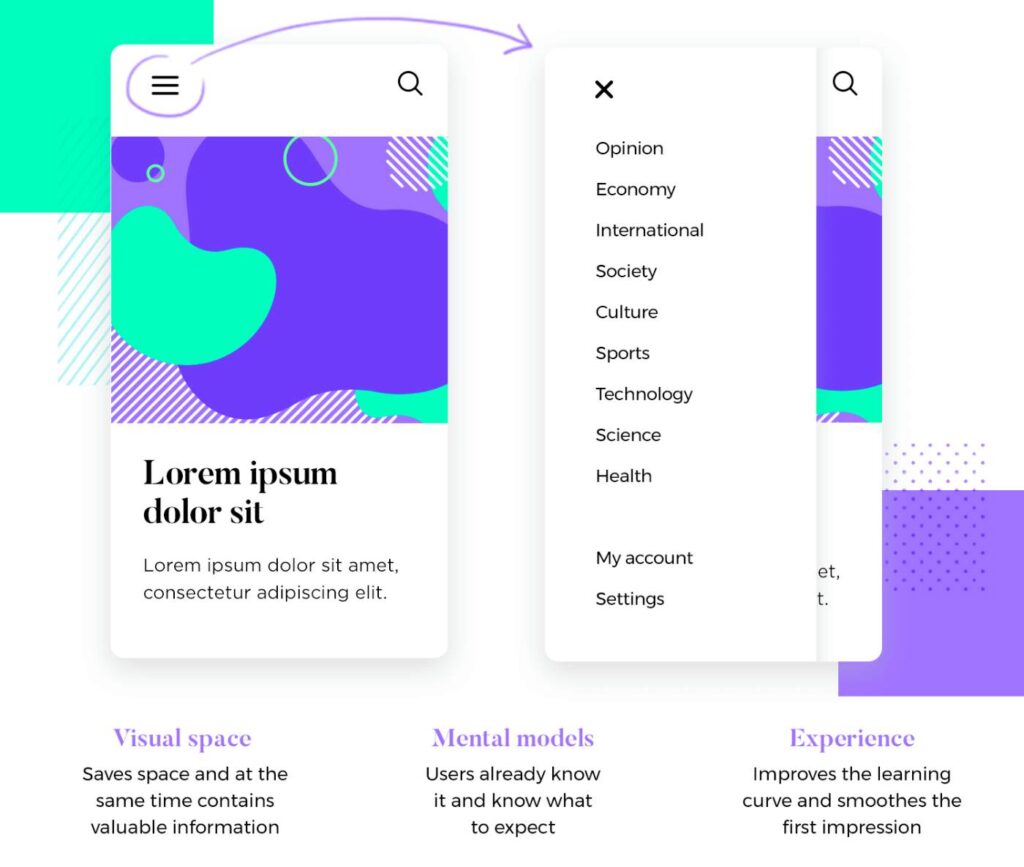
Selecting a certain webpage area for your ads is crucial so as not to obstruct consumers from exploring your website. To put it another way, you must arrange the content and advertisements so that users will find them useful.
Ensuring Clear and Concise Call-To-Action (CTA) Buttons
Everyone can use effective CTAs. First of all, this entails making sure that they can be seen when needed. The CTA copy for each button or link that performs the same action or directs the user to the same location should be identical.

Good CTAs are affordant, which means that their purpose and nature are obvious. In truth, some elements are naturally clickable, such as links, which are frequently underlined by default to help users distinguish them from the text that isn’t clickable. Pay particular attention to the horizontal padding around buttons, if you use them as your CTAs, to ensure it looks appealing and balanced.
Testing and Iteration
Examine the types of advertisements your competitors are using, where they are applying them, how they are placing them on their landing pages, etc. Make your ads look viewable. Check that the ads are loading quickly and not interfering with the user’s experience.
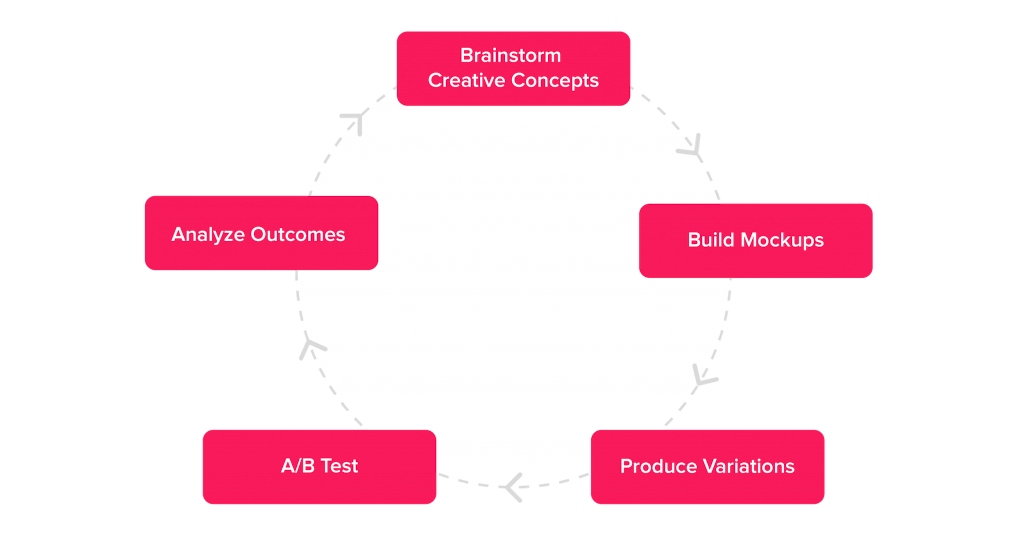
You will need to continuously optimize your advertising if you want to be able to meet the needs of various users when you advertise using UX. To improve user experience, you can also decide to include SaaS language translation and audio, video, and text chat capabilities.
A/B Testing for Mobile Ad Campaigns
This technique is used by advertisers in mobile marketing to test various aspects of their ad campaigns. Examples include campaign objectives, creatives, audiences, and placements. In conventional marketing, A/B testing results depend on the first decision made by the advertisers. There is no turning back from their decisions, which determine whether the campaign will succeed or fail.
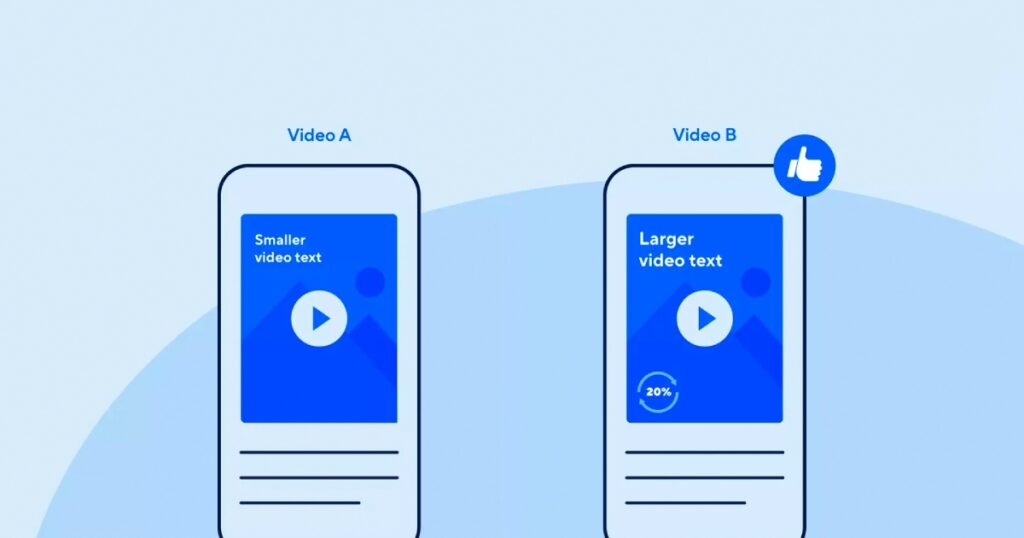
On the other hand, everything in mobile marketing can be tested. Although it’s not something marketers can do, they must. The only way to determine whether something will function or not is through testing. The best-performing ads can only be discovered via applying science.
Gathering User Feedback for Continuous Improvement
Each UX designer is doing their best with what they know and can do. However, helpful criticism is what pushes you forward and results in a stronger UX design. Therefore, designers should experiment in cooperating with marketers until they achieve the desired outcomes.

Ask testers to provide comments on your website’s or app’s UX design and the accuracy of the placement of the adverts. Carry out the testing in various locations and on various devices.
Future Trends and Considerations
As technology develops and consumer expectations rise, marketers can struggle to stay on top of mobile marketing trends. The digital world develops so quickly that failing to catch a trend or employing antiquated techniques can hinder your success and cause your brand to lose credibility and industry trust. Data demonstrates how much opportunity a brand may pass up if mobile marketing is not a key component of its digital strategies.
Emerging Technologies in Mobile Advertising
- It’s a reasonably typical company practice — and for a good reason — to deploy AI chatbots to guarantee users have a flawless mobile buying experience. They offer the glimmer of humanity your audience is looking for while resolving issues and responding to inquiries. By 2024, it’s anticipated that the chatbot market will reach $1.3 billion, making this the ideal time to incorporate them into your mobile marketing plan.
- After the world pandemic, voice search became another huge trend. Users applied voice search or assistance to get essential information or finish chores while avoiding infections and interaction with too many objects. Marketers must ensure that their mobile sites are voice search prepared and traditionally SEO optimized.
- Visual search. There are a few ways that smartphones can search for items using a camera image. Image metadata is used in the first. The search feature conducts a deep text-based search to look for precise terms about color, form, and other parameters when certain properties of the image are tagged. Reverse image search is another visual search approach: an algorithm searches for comparable images based on AI-detected aspects of the picture.
AI can be useful for increasing profits not only as chatbots. Read more in the article “Ringostat AI: instant analysis of customer conversations is the future of sales”.
Adapting to Changes in User Behavior and Preferences
Consumers and buyers value and demand highly individualized customer experiences (CX), particularly for mobile devices. However, personalization is nothing new. Therefore, in order to stand out in 2023 and beyond, any business must be hyper-personal and innovative.
Interacting with consumers becomes simpler if you better understand their interests. According to Adobe’s Digital Trends research, 50% of companies that perform well in digital marketing have “significant insight” into the modern consumer journey.
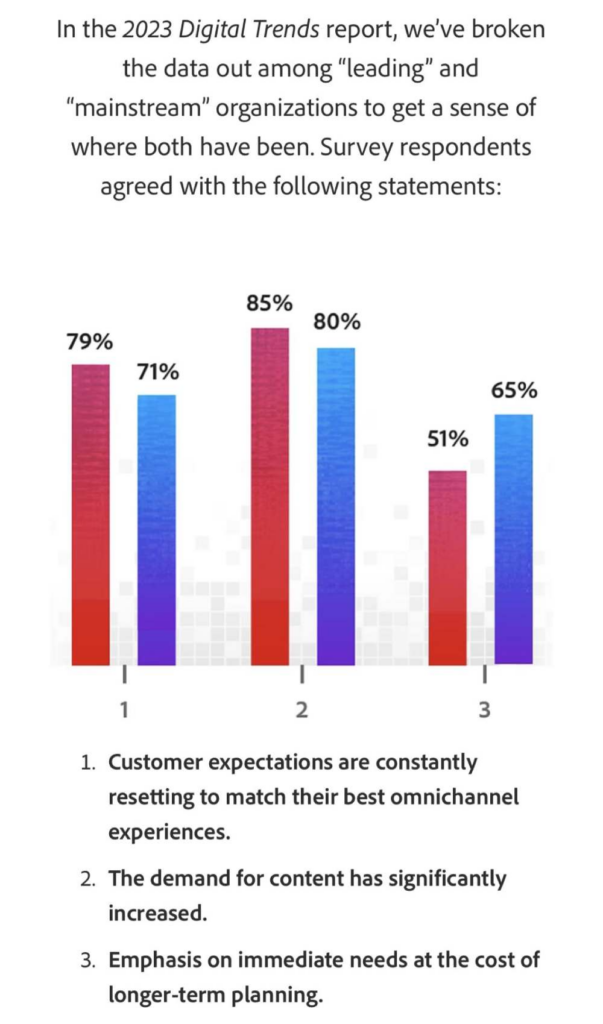
Standing apart from the competition is a significant concern for most mobile marketers. A person may watch between 6,000 and 10,000 advertisements on average per day. That’s a lot! You want potential buyers to remember your advertisement or take action after seeing it. You may increase the effectiveness of your ad spend by 30% by distributing the appropriate material to the right prospect at the right time. By using content personalization, you can ensure that your audience sees content that matches their preferences and routines.
Privacy Concerns and Regulatory Compliance
By instituting an opt-in mechanism for each app user download, Apple’s ATT and Google’s mobile privacy plans aim to provide customers with the choice of not disclosing their personal data easily. As a result, marketers can no longer accurately target customers with tailored offers and retargeted ads by tracking their mobile behavior.
This harms the effectiveness of mobile marketing. Small-scale platforms offering permission management and performance marketing solutions for advertisers have started to increase within the advertising ecosystem. This is their first response to these fundamental changes in how mobile ads have previously been provided to consumers. At the same time, smaller independent players frequently find it difficult to handle regulatory compliance.
Targeting by advertisers is primarily reliant on user activity data. This approach now becomes exceedingly challenging because there is a lack of user-level behavioral data. Advertisers are also unable to retarget individuals who abandon the targeted consumer journey without a unique ID.
Bottom Line
Briefly said the “mobile first” approach is crucial to any product design and promotion. On the one hand, it increases marketing campaign productivity and helps to cut down on product development time and cost. On the other hand, it compels the whole product team to focus more on a product’s content, which enables them to produce clean and useful designs.
The “move first” debate may not remain forever, though, as smartphones continue to improve and become less and less seen as “lower ends” in the near future. However, for the time being, its importance for advertising cannot be disregarded.
Industry-specific best practices for mobile marketing for small businesses differ, but these concepts are common throughout the marketing world. Keep the following in mind as you prepare to launch your next campaign.
- Compared to marketing for desktops, mobile marketing is different. The content should be more concise and interesting.
- People prefer to see targeted marketing materials. Personalization increases sales through everything from emails to discount codes.
- The quickest path to an effective campaign is automation. Utilizing marketing technologies facilitates reaching out to customers more frequently.
Your upcoming marketing campaign will inevitably go smoothly if you apply the aforementioned mobile-first marketing methods. Digital marketing is still developing. Start setting up each channel for success now if you want your company to maintain a strong online presence in 2023. Mobile marketing ought to be the focal point of your plan. Overall, your top priority should be to improve the customer’s journey and offer users highly personalized advertising content.


